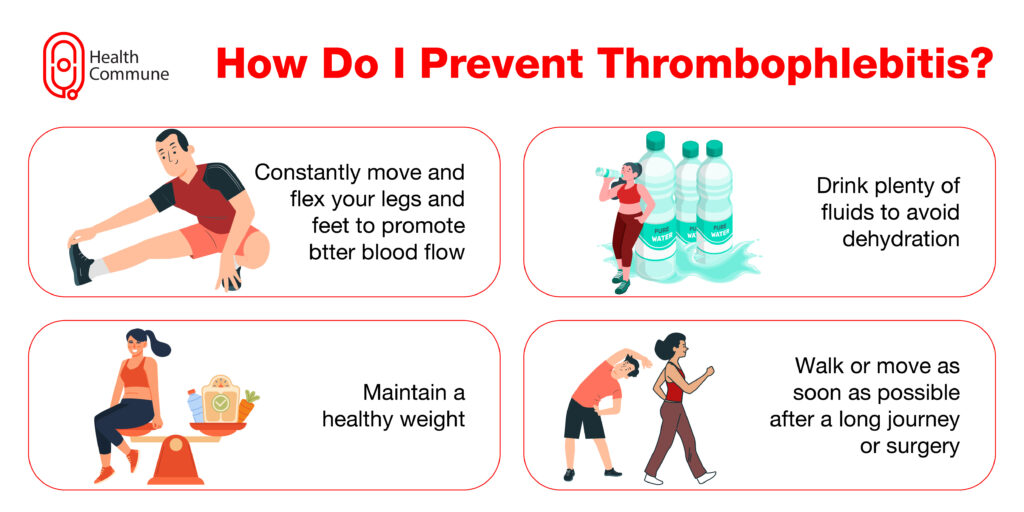Thrombophlebitis can arise due to multiple reasons. Read on to learn more about this condition, its types, what causes it, and how it is diagnosed and managed.
What is thrombophlebitis?
Thrombophlebitis is when a vein in your body gets inflamed due to the formation of a blood clot. This condition is most commonly seen in the legs.
What are the types of thrombophlebitis?
Depending on which type of veins are involved, this condition can be divided into:
- Superficial thrombophlebitis: This occurs in a vein close to the surface of the body
- Deep vein thrombosis: This occurs in one of the deeper veins and is more serious
What causes thrombophlebitis?
This condition occurs due to blood clot formation. This can happen either when the vein is injured, or when the blood through the vein becomes sluggish.
What are the risk factors for thrombophlebitis?
You’re at a higher risk if:
- You’re over 60 years of age
- You have varicose veins
- You have a central venous catheter or a recent IV line
- You’ve recently suffered from some kind of trauma or accident
- You’ve recently had major surgery and you’ve been on bed rest for more than 3 days
- You’re pregnant or have recently given birth
- You’ve been travelling and sitting in the same position for a long time, for example, on a long flight or bus journey
- You regularly take contraceptives or birth control pills or you’re on hormone replacement therapy
- You’re overweight or obese
- You’re suffering from some kind of debilitating disease that requires prolonged bed rest or has impacted your mobility
- You have certain clotting disorders such as deficiency of protein C, protein S, factor V of Leiden, etc.
- You’re suffering from cancer
What are the symptoms of thrombophlebitis?
Your symptoms depend on the type of thrombophlebitis.
In the case of superficial thrombophlebitis, you will notice:
- Pain in the affected area
- Redness and warmth
- Swelling
- Discoloured skin
In the case of deep vein thrombosis (DVT), you will notice:
- Fever
- Pain and swelling in your legs and calf muscles
- Difficulty walking or moving your legs
- Changes in the colour of your skin
- Warmth in your leg

Do I need to see a doctor for thrombophlebitis?
Immediately go to the hospital if you’re experiencing the following symptoms:
- Breathlessness
- Chest pain
- Blood in your cough
- Lightheadedness or dizziness
How is thrombophlebitis diagnosed?
Your doctor will ask you about your symptoms and examine the affected leg for swelling, tenderness, skin and temperature changes. Based on this, you’ll be advised to undergo:
- Duplex ultrasound: This is like an ultrasound where sound waves are used to differentiate between superficial thrombophlebitis and deep vein thrombosis. The normal sound in your vein will be absent if you have deep vein thrombosis
- D-dimer test: This is a blood test where D-dimer levels are checked to rule out the presence of DVT. D-dimer is a protein that’s associated with blood clots
- Blood or genetic testing: Your doctor can recommend these tests if they suspect a bleeding disorder or some kind of genetic disorder
- MR or CT venogram: In this, your doctor injects contrast material into your vein to check the flow of blood and detect blockage
- CT or MRI scan: This is used in cases where a pulmonary embolism is suspected or in cases of cancer
How is thrombophlebitis treated?
Superficial cases usually resolve on their own. Occasionally your doctor can recommend over-the-counter painkillers and advise you to keep a hot water bag over the affected area. In more serious cases, they will advise:
- Blood thinners (anticoagulants), which are drugs that prevent the formation of blood clots. Most commonly prescribed blood thinners include warfarin, and heparin (Note: Warfarin can’t be used in pregnant women since it is harmful to the baby)
- Fibrinolysins are drugs that dissolve any pre-existing clots that may be present in your veins
- Bandaging your entire leg with a crepe bandage and keeping it elevated
- IVC filter is a filter that is fitted into the major vein of your body (IVC or inferior vena cava). It filters out any clots and prevents them from reaching your heart, thus reducing your chances of developing a pulmonary embolism
- Surgery in severe cases, where a part of the blocked vein is removed and the remaining ends are connected end-to-end, like a bypass
- Surgery in case you have varicose veins, where your surgeon makes small incisions in your leg and removes the affected vein
What are the complications of thrombophlebitis?
Complications include:
- Pulmonary embolism, where the clot from your deep vein travels to your lungs and gets lodged there, blocking the blood flow
- Post-phlebitic syndrome, in which there is chronic pain and swelling of the affected leg after DVT
How can I prevent thrombophlebitis?
Some precautions include:
- Walking or moving as soon as possible after a long journey or surgery
- Constantly moving and flexing your legs and feet to promote better blood flow
- Maintaining a healthy weight
- Drinking plenty of fluids to avoid dehydration
How is thrombophlebitis related to cancer?
In some cancers, repeated episodes of inflammation of your veins are seen which initially involve one area of the body, and they disappear and reappear in another part of the body. This is called migratory thrombophlebitis, or Trousseau syndrome. It is associated with cancers of the internal organs, like the lungs, colon or pancreas.


